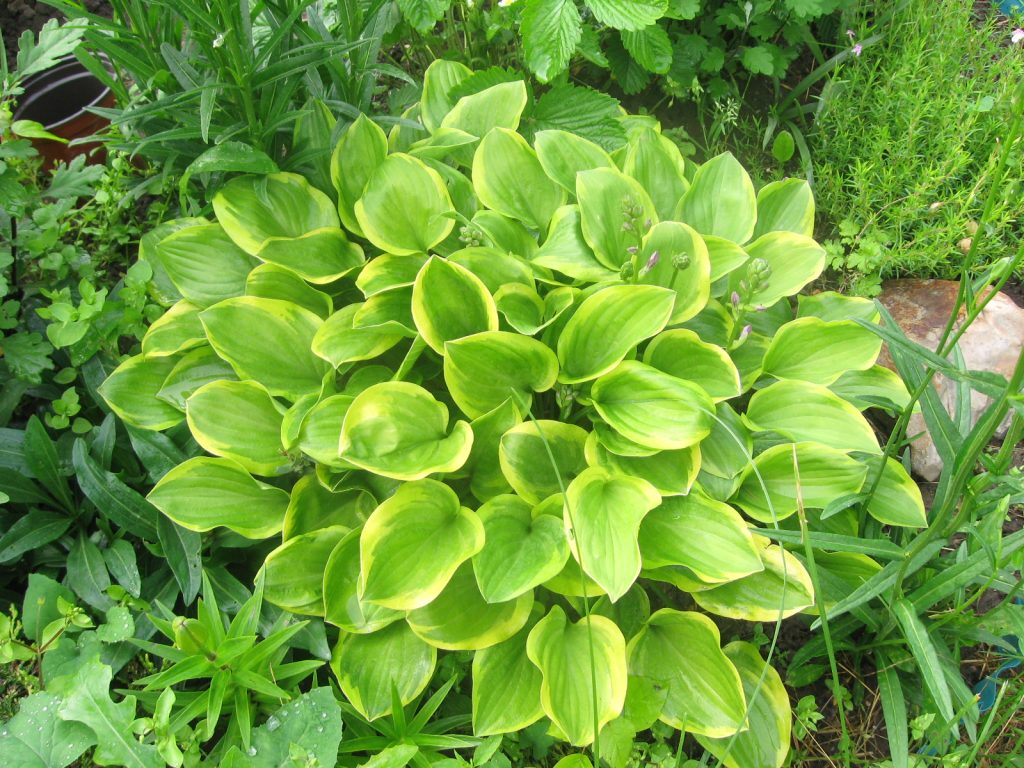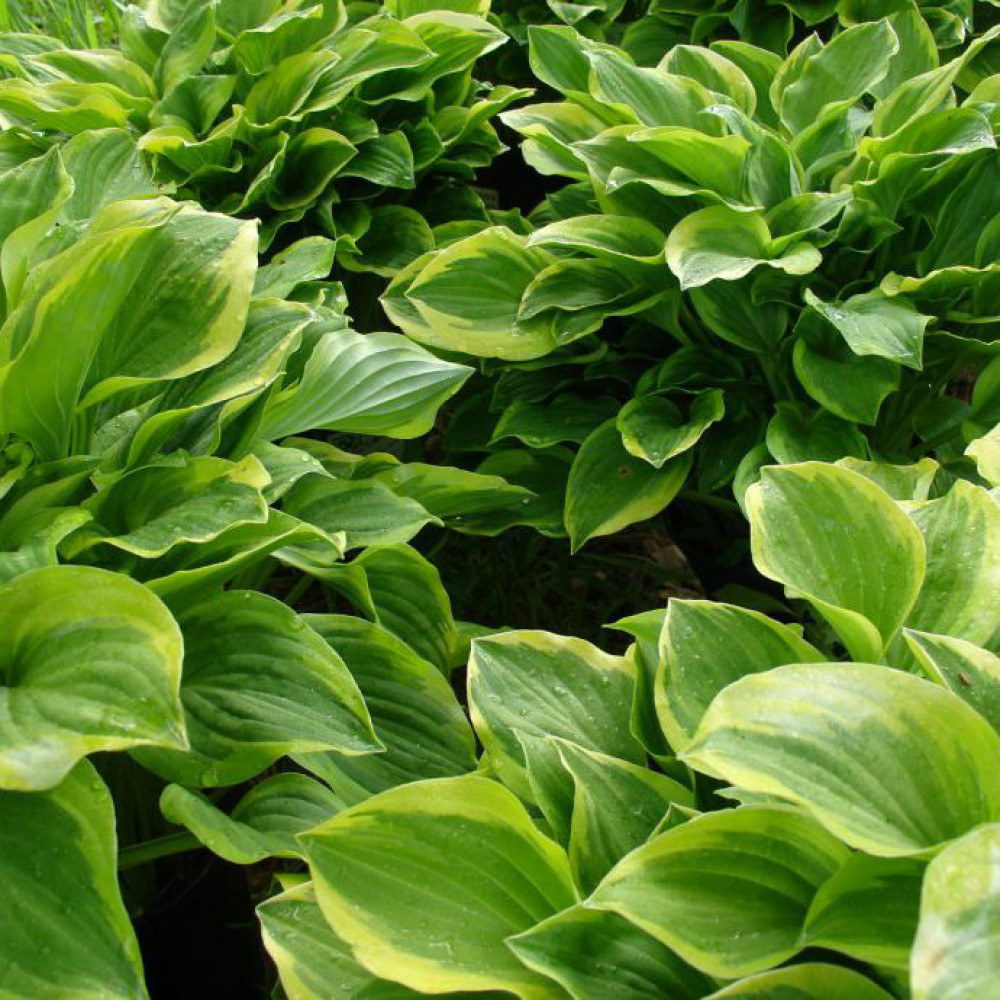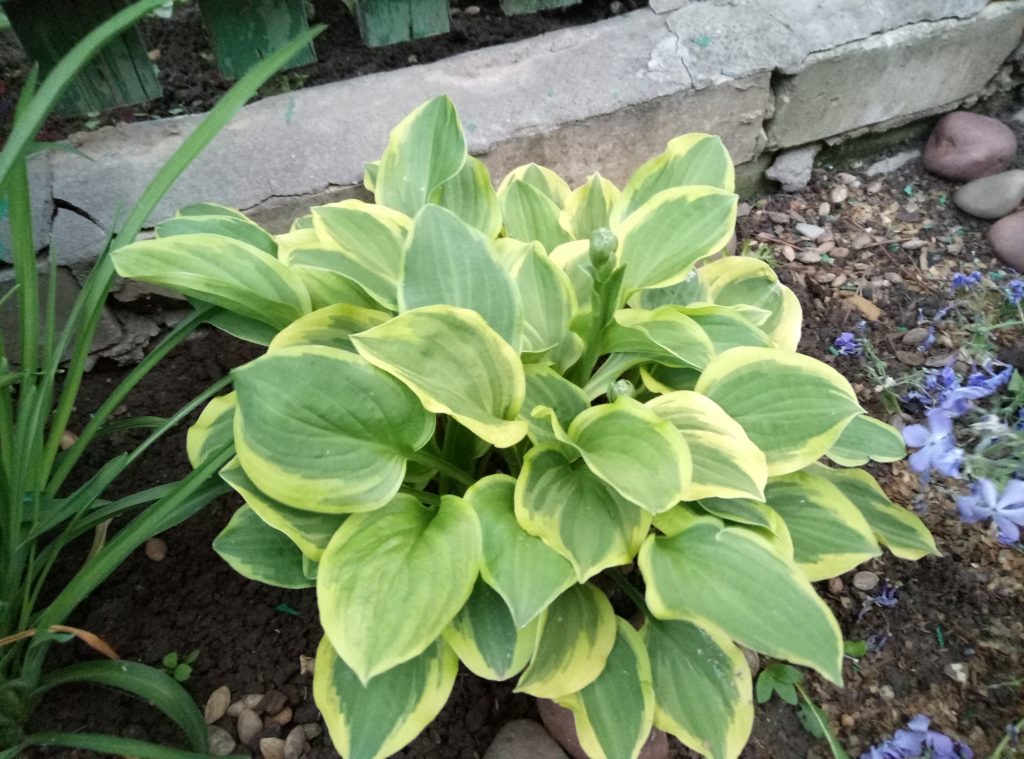Hosta Golden Tiara - an elegant plant for the garden
The perennial hosta Golden Tiara is a beautiful, domed plant with variegated foliage that is very popular in today's landscape. A winter-hardy crop is suitable for growing throughout our country. Consider the main characteristic of the variety, the rules of planting and care.

Hosta Golden Tiara Photo
Description of the plant
Hosta Golden Tiara (Latin Hosta hybrida Golden Tiara) is a perennial ornamental crop with a very lush and wide crown, height 40-45 cm.
Leaves are formed at the very rhizome, are located on petioles, corrugated, round or heart-shaped, light green with a beige edging along the edge.
It produces thin peduncles 50-60 cm long, bell-shaped small lavender flowers, collected in racemose inflorescences, bloom at the top of each.
Flowering occurs in July-August, it is characterized by rapid growth - up to 7-8 cm per year.
Landing rules
For planting the decorative Golden Tiara hosts choose a shaded place with access to sunlight in the morning and evening hours. It is important that the site is not swampy and with a neutral level of soil acidity.
The soil is suitable light, loose, with a high content of organic and mineral substances. Grows well on loamy soil with the addition of sand or perlite.
A hole is pulled out 40 cm deep and 50 cm wide. Fill in half with a mixture of dug soil and humus (compost). The proportions are 1: 1.
Then the root system of the seedling is lowered so that the root part remains above the soil surface.
All voids are filled up, crushed in the near-trunk zone, moistened. So that the plant does not dry out, it is mulched with peat and in the first two weeks it is sheltered from the scorching sun.
For group planting, the scheme is maintained - 40x50 cm.
Care requirements
Taking care of the hosta is not difficult, all she needs is regular moisturizing, loosening and feeding.

Hosta golden tiara
Watering
Watered often, because in moist soil, the leaves develop larger and more juicy than in overdried.
Frequency during the growing season - every 3-4 days, provided that the summer turned out to be dry and hot.
They use settled and warm water - 5 liters are enough for one bush. The next day after watering, the soil is loosened, weeds are removed, mulch is applied from peat or compost.
Top dressing
Starting from three years old, fertilize according to the following scheme:
- in the spring (in April and May), a mineral dressing containing nitrogen, phosphorus and potassium is introduced - 1 tbsp each. l. for 10 liters of water;
- in the summer they are fed with superphosphate and potassium sulfate - 15 g per bucket of water;
- in the fall, leaf compost or peat is covered up in the near-trunk circle.
All fertilizers are combined with irrigation to improve the quality of nutrient absorption.
Pruning
From spring to autumn, yellowed, dried and withered leaves are removed from the crown to prevent infection with diseases and pests.
Also cut the flower arrows to the base.After cutting, you can process the crown with Epin and Zircon so that the hosta recovers faster.
Preparing for winter
A week before the coming cold weather, all the foliage is cut out, the rest of the shrub is sprinkled with a thick layer of peat, sawdust.
Reproduction
Cuttings
This is not the most popular method for poorly growing bushes or plants with rotten roots.

Hosta Golden Tiara Description
For planting, you will need a stalk torn off with a heel or several roots without digging out the rhizome.
On the shoot, the leaves are shortened by half the length. They are planted in open ground or under a greenhouse in a mixture of peat and sand. Moisturize, shade from the scorching sun every day.
As soon as new leaves appear on the handle, it can be considered that the reproduction was successful. They continue to look after adult plants.
By dividing the bush
In the spring, when it gets warm, the bush is watered, dug up, washed under water to wash off the remnants of the soil. Then cut with a shovel or knife into pieces so that each has roots and at least one bud.
Places of cuts are sprinkled with charcoal, after drying, they are seated separately.
Seeds
This method is not very effective and is rarely used by gardeners. In addition, it is difficult to provide seedlings with proper care at home, and they reach their maximum decorative effect only at the 4th year of life.
Such breeding is used more in industrial horticulture to develop new varieties and hybrids.
Diseases and pests
It can be damaged by various infections and pests. Therefore, in early spring and late autumn, the crown is irrigated with fungicides for diseases. In case of an invasion of parasites, insecticides are used.
For prevention, it is recommended to buy healthy seedlings, follow the planting scheme, regularly loosen the soil, remove weeds, and cut out diseased parts on the bush.
Application rules in the landscape
This decorative leafy culture is used in different compositions - they are planted in mixborders, rabatkas, rock gardens, rockeries. They are planted in alleys, along curbs, fences.

Hosta golden tiara photo and description
A perennial looks beautiful in the center of the flower bed, surrounded by undersized bright flowering plants. It goes well with mosses, heather and other hosta varieties.
Cut leaves are used to create colorful bouquets and compositions.
Variety reviews
Host Golden Tiara has received many positive reviews from gardeners:
- some fell in love with the shrub for its simplicity in care - it does not need to be shaped, when laying nutrients it grows well on any type of soil;
- others like that it can be combined with different flowers in the garden, which makes it possible to grow the most unusual and original composition;
- the plant is compact, therefore it does not take up much space in the flower garden.

